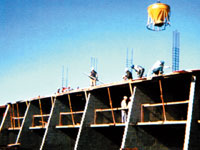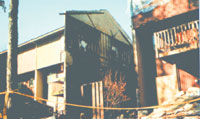Today’s building code officials should be encouraged to develop code provisions that provide an improved level of redundancy for life safety, property protection, and welfare of the general public. Owners and designers should be aware of the life safety and property protection benefits of balanced design. In a related article the findings of the report on the World Trade Center disaster confirm the superior performance of buildings where concrete and masonry were used as passive fire protection of structural elements.
Where the Codes Fit In

The recent merger of the three major model building code organizations into the International Code Council resulted in a family of codes for the built environment. The new International Building Code (IBC) is a compilation of the requirements found in the legacy codes of the three predecessor organizations. Unfortunately, it has adopted the least conservative passive fire protection requirements from the three legacy codes. In addition, new code change proposals continue to be submitted that will further relax the passive fire protection requirements for buildings.
Conversely, Portland Cement Association (PCA) and allied industry groups advocate changes to increase the passive fire protection for buildings in an effort to reinstate the level of fire protection provided by prior codes. Portland Cement Association and allied masonry and concrete groups continue to promote balanced design—appropriate combinations of non-combustible, fire-resistive floors and walls providing compartmentation, automatic fire sprinklers, and smoke detection systems.
Seven Reasons to Rethink Sprinkler Trade-Offs
The continued relaxation of passive fire protection as a trade-off for the increased use of sprinklers may not be appropriate for adequate life safety, property protection, and welfare of the public.
Consider the following:
- Aging population. The number of people aged 65 years of age and older will peak around the year 2030. These older adults tend to have hearing, visual, mental, or physical impairments and comprise about 25 percent of all fire deaths.
- Nearly 10 percent of all structure fires are intentionally set. In such fires, if automatic suppression systems are present, they may be deliberately disabled, or the fire may be set in a fashion to overcome the sprinkler system.
- The codes have become more stringent in other areas, such as structural performance and energy conservation. Better fire provisions, meaning providing for increased life safety and property protection, deserve to receive a similar, if not greater, level of attention.
- Increased use of multi-family construction. Apartment buildings and college dormitories continue to grow in number. Without the appropriate combination of passive fire protection and automatic detection and suppression systems, are the occupants adequately protected?
- Sprinkler effectiveness. Operational reliability and performance reliability are not the same. Operational reliability, usually in the 95 to 99 percent range, means that when the temperature reaches the design temperature, the sprinkler head will operate. Performance reliability, the ability of sprinklers to control or extinguish a fire, is considerably less than operational reliability. Until sprinkler performance reliability approaches 100 percent, redundancy (two-hour noncombustible fire barriers) needs to be incorporated into multi-family occupancies.
 It is not enough to have automatic detection and suppression equipment. Redundancy for fire safety—non-combustible masonry and concrete separations—is necessary. In fact, designers should consider exceeding the greatly relaxed minimum life safety provisions in the International Building Code by specifying minimum two-hour non-combustible walls and floors to separate living units in multi-family construction. Automatic suppression and detection systems should accompany noncombustible construction, but sprinkler trade-offs should be eliminated.
It is not enough to have automatic detection and suppression equipment. Redundancy for fire safety—non-combustible masonry and concrete separations—is necessary. In fact, designers should consider exceeding the greatly relaxed minimum life safety provisions in the International Building Code by specifying minimum two-hour non-combustible walls and floors to separate living units in multi-family construction. Automatic suppression and detection systems should accompany noncombustible construction, but sprinkler trade-offs should be eliminated.